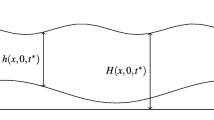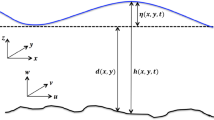Abstract
A localized truncation error analysis with complex derivatives (LTEA+CD) is applied recursively with advanced circulation (ADCIRC) simulations of tides and storm surge for finite element mesh optimization. Mesh optimization is demonstrated with two iterations of LTEA+CD for tidal simulation in the lower 200 km of the St. Johns River, located in northeast Florida, and achieves more than an over 50% decrease in the number of mesh nodes, relating to a twofold increase in efficiency, at a zero cost to model accuracy. The recursively generated meshes using LTEA+CD lead to successive reductions in the global cumulative truncation error associated with the model mesh. Tides are simulated with root mean square error (RMSE) of 0.09–0.21 m and index of agreement (IA) values generally in the 80s and 90s percentage ranges. Tidal currents are simulated with RMSE of 0.09–0.23 m s−1 and IA values of 97% and greater. Storm tide due to Hurricane Matthew 2016 is simulated with RMSE of 0.09–0.33 m and IA values of 75–96%. Analysis of the LTEA+CD results shows the M2 constituent to dominate the node spacing requirement in the St. Johns River, with the M4 and M6 overtides and the STEADY constituent contributing some. Friction is the predominant physical factor influencing the target element size distribution, especially along the main river stem, while frequency (inertia) and Coriolis (rotation) are supplementary contributing factors. The combination of interior- and boundary-type computational molecules, providing near-full coverage of the model domain, renders LTEA+CD an attractive mesh generation/optimization tool for complex coastal and estuarine domains. The mesh optimization procedure using LTEA+CD is automatic and extensible to other finite element-based numerical models. Discussion is provided on the scope of LTEA+CD, the starting point (mesh) of the procedure, the user-specified scaling of the LTEA+CD results, and the iteration (termination) of LTEA+CD for mesh optimization.












Similar content being viewed by others
References
Advanced Circulation (ADCIRC) (2017) The official ADCIRC website. http://adcirc.org/. Accessed online 17 Mar 2017
Bacopoulos P (2017) Tide-surge historical assessment of extreme water levels for the St. Johns River: 1928–2017. J Hydrol 553:624–636
Bacopoulos P, Funakoshi Y, Hagen SC, Cox AT, Cardone VJ (2009) The role of meteorological forcing on the St. Johns River (northeastern Florida). J Hydrol 369:55–70
Bacopoulos P, Parrish DM, Hagen SC (2011) Unstructured mesh assessment for tidal model of the South Atlantic bight and its estuaries. J Hydraul Res 49:487–502
Bacopoulos P, Kubatko EJ, Hagen SC, Cox AT, Mulamba T (2017) Modeling and data assessment of longitudinal salinity in a low-gradient estuarine river. Environ Fluid Mech 17:323–353
Berger MJ, Colella P (1986) Local adaptive mesh refinement for shock hydrodynamics. J Comput Phys 82:64–84
Bourgerie R (1999) Currents in the St. Johns River, Florida: spring and summer of 1998. NOAA technical report NOS CO-OPS 025, Washington, DC, 67 p
Chang S, Haworth DC (1995) Kinetic-energy-balance based solution-adaptive mesh refinement. In: Johnson RW, Hughes ED (eds) Quantification of uncertainty in computational fluid dynamics—Volume 213. American Society of Mechanical Engineers, New York, pp 7–12
Chen C, Beardsley RC, Cowles G (2006) An unstructured grid, finite-volume coastal ocean model (FVCOM) system. Oceanography 19:78–89
Cheng RT, Casulli V, Gartner JW (1993) Tidal, residual, intertidal mudflat (TRIM) model and its applications to San Francisco Bay, California. Estuar Coast Shelf Sci 36:235–280
Conroy CJ, Kubatko EJ, West DW (2012) ADMESH: an advanced, automatic unstructured mesh generator for shallow water models. Ocean Dyn 62:1503–1517
Danish Hydraulic Institute (DHI) (2016) Mike 21: 2D modeling of coast and sea. https://www.mikepoweredbydhi.com/products/mike-21. Accessed online October 10, 2016
Deltares (2016) Delft3D 4 suite (structured). https://www.deltares.nl/en/software/delft3d-4-suite/. Accessed online October 10, 2016
Ferguson JO, Jablonowski C, Johansen H, McCorquodale P, Colella P, Ullrich P (2016) Analyzing the adaptive mesh refinement (AMR) characteristics of a high-order 2D cubed-sphere shallow-water model. Mon Weather Rev 144:4641–4666
Foreman MGG, Henry RF, Walters RA, Ballantyne VA (1993) A finite element model for tides and resonance along north coast of British Columbia. J Geophys Res 98:2509–2531
Franca AS, Haghighi K, Oliveira LS (1995) Error estimation and adaptivity in finite element analysis of transport problems. In: Johnson RW, Hughes ED (eds) Quantification of uncertainty in computational fluid dynamics—Volume 213. American Society of Mechanical Engineers, New York, pp 19–24
Giardino D, Bacopoulos P, Hagen SC (2011) Tidal spectroscopy of the lower St. Johns River from a high-resolution shallow water hydrodynamic model. Int J Ocean Clim Syst 2:1–18
Hagen SC, Westerink JJ, Kolar RL, Horstmann O (2001) Two-dimensional, unstructured mesh generation for tidal models. Int J Numer Methods Fluids 35:669–686
Hagen SC, Zundel AK, Kojima S (2006) Automatic, unstructured mesh generation for tidal calculations in a large domain. Int J Comput Fluid Dyn 20:593–608
Hannah CG, Wright DG (1995) Depth dependent analytical and numerical solutions for wind-driven flow in the coastal ocean. In: Lynch DR, Davies AM (eds) Quantitative skill assessment for Coastal Ocean models—volume 47. American Geophysical Union, Washington, pp 125–152
Henrie K, Valle-Levinson A (2014) Subtidal variability in water levels inside a subtropical estuary. J Geophys Res (Oceans) 119:7483–7492. https://doi.org/10.1002/2014JC009829
Ilin AV, Bagheri B, Metcalfe RW, Scott LR (1997) Error control and mesh optimization for high-order finite element approximation of incompressible viscous flow. Comput Methods Appl Mech Eng 150:313–325
Jordi A, Georgas N, Blumberg A (2017) A parallel domain decomposition algorithm for coastal ocean circulation models based on integer linear programming. Ocean Dyn 67:639–649
Kubatko EJ, Westerink JJ, Dawson C (2006) hp discontinuous Galerkin methods for advection dominated problems in shallow water flow. Comput Methods Appl Mech Eng 196:437–451
Lohner R (1987) An adaptive finite element scheme for transient problems in CFD. Comput Methods Appl Mech Eng 61:323–338
Luettich RA, Westerink JJ, Scheffner NW (1992) ADCIRC: an advanced three-dimensional circulation model for shelves, coasts and estuaries, I: theory and methodology of ADCIRC-2DDI and ADCIRC-3DL. Technical report DRP-92-6, Washington, DC, 144 p
Medeiros SC, Hagen SC (2013) Review of wetting and drying algorithms for numerical tidal flow models. Int J Numer Methods Fluids 71:473–487
National Oceanographic and Atmospheric Administration-National Ocean Service (NOAA-NOS) (2017) Center for Operational Oceanographic Products and Services. http://tidesandcurrents.noaa.gov/. Accessed online March 6, 2017
Oden JT, Demkowicz L, Rachowicz W, Westermann TA (1990) A posteriori error analysis in finite elements: the element residual methods for symmetrizable problems with applications to compressible Euler and Navier-Stokes equations. Comput Methods Appl Mech Eng 82:183–203
Open Telemac-Mascaret (2016) The mathematically superior suite of solvers. http://www.opentelemac.org/. Accessed online October 10, 2016
Orton P, Georgas N, Blumberg A, Pullen J (2012) Detailed modeling of recent severe storm tides in estuaries on the New Year City region. J Geophys Res 117:C09030. https://doi.org/10.1029/2012JC008220
Parrish DM, Hagen SC (2007) 2D unstructured mesh generation for oceanic and coastal tidal models from a localized truncation error analysis with complex derivatives. Int J Comput Fluid Dyn 21:277–296
Parrish DM, Hagen SC (2009) Incorporating spatially variable bottom stress and Coriolis force into 2D, a posteriori, unstructured mesh generation for shallow water models. Int J Numer Methods Fluids 60:237–261
Remacle JF, Lambrechts J (2016) Fast and robust mesh generation on the sphere: application to coastal domains. Procedia Eng 163:20–32
Schubert JE, Sanders BF, Smith MJ, Wright NG (2008) Unstructured mesh generation and landcover-based resistance for hydrodynamic modeling of urban flooding. Adv Water Resour 31:1603–1621
Toth DJ (1993) Volume 1 of the Lower St. Johns River basin reconnaissance: Hydrogeology. Technical Report SJ93-7, St. Johns River Water Management District, 58 p
Westerink JJ, Muccino JC, Luettich RA (1994) Modeling tides in the western North Atlantic using unstructured graded grids. Tellus 46A:178–199
Westerink JJ, Luettich RA, Feyen JC, Atkinson JH, Dawson C, Roberts HJ, Powell MD, Dunion JP, Kubatko EJ, Pourtaheri H (2008) A basin- to channel-scale unstructured grid hurricane storm surge model applied to southern Louisiana. Mon Weather Rev 136:833–864
Willmott CJ, Robeson SM, Matsuura K (2011) A refined index of model performance. Int J Climatol 32:2088–2094
XMS Wiki (2017) SMS: Paving. http://www.xmswiki.com/wiki/SMS:Paving. Accessed online March 14, 2017
Acknowledgements
D. Michael Parrish and Matthew V. Bilskie provided assistance with the implementation of LTEA+CD. The author thanks Scott C. Hagen for inspiration of the concept and providing detailed advice. The author also thank the three anonymous reviewers for providing insightful comments that served to vastly improve the paper. The data used in this study are available from the cited references.
Funding
The author did not receive any funding support for this work.
Author information
Authors and Affiliations
Corresponding author
Ethics declarations
Conflict of interest
The author declares that he has no competing interests.
Additional information
Responsible Editor: Pierre F.J. Lermusiaux
Rights and permissions
About this article
Cite this article
Bacopoulos, P. Automatic, unstructured mesh optimization for simulation and assessment of tide- and surge-driven hydrodynamics in a longitudinal estuary: St. Johns River. Ocean Dynamics 68, 535–551 (2018). https://doi.org/10.1007/s10236-018-1151-y
Received:
Accepted:
Published:
Issue Date:
DOI: https://doi.org/10.1007/s10236-018-1151-y




